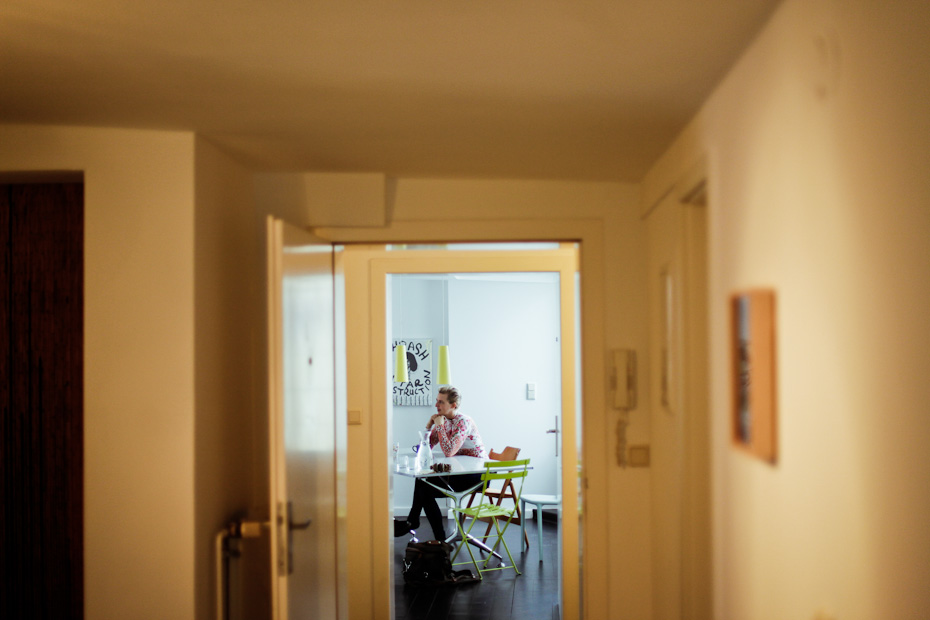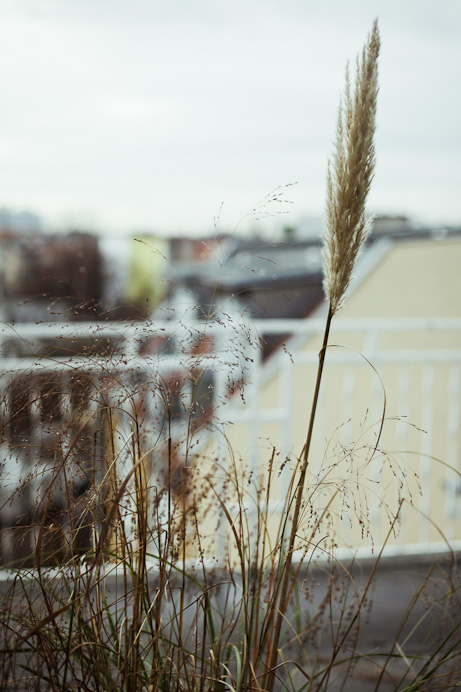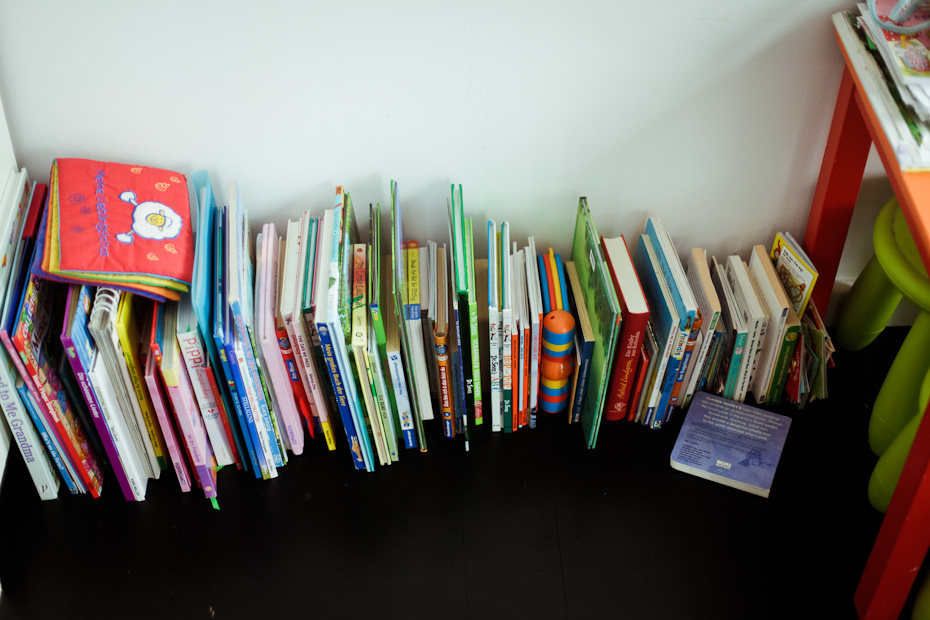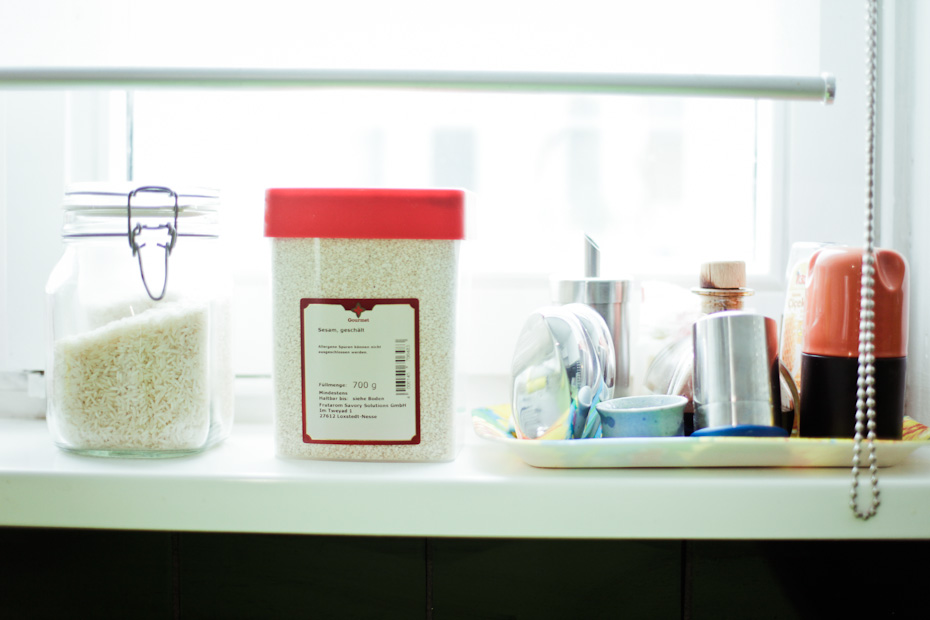It’s a bleak and grey winter day. We ascend the never-ending stairwell of an apartment building in Berlin’s Wedding district. Gallerist Sabine Schimdt opens the door and we enter a world, which much to our surprise is (almost) entirely art-free.
After visiting her PSM gallery, however, it all comes full circle: here you can feel the energy and enthusiasm of a gallerist who has found her own special way of continuing on a family tradition. Artist Christian Falsnaes aggressive screams echo from the remnants of a performance installation. During our conversation we will find out how Sabine Schmidt found her way into the art world and why a question about oak trees played a significant role.








































Do you have objects in your apartment that have a particular meaning to you?
This tiger is my favorite object. It was a present I bought for my boyfriend when we first met. He likes album covers and, generally, 80s design–trashiness. One day I came across this tiger in a flower shop in Wedding. It was just standing there between the flowers. So I lugged this enormous animal home. It’s been a member of our family ever since. Other than that, our apartment is pretty minimal, very bare. I like it because I can let my mind wander here and don’t have to think about what to hang next–it truly is my safe haven.
Where do you come from originally?
I was born and raised in the Hochsauerland region in North Rhine-Westphalia. It’s great growing up there as a kid and becomes petty boring as a teenager.
Why?
All you can do is drink beer. We’re pretty famous for the different types of beer in our region (laughs…)
How did you become interest in art?
I discovered the art world through my mother, who took me to the Documenta exhibitions. So every five years I delved into this different world with her. I was incredibly fascinated by it, not only because of the people you could meet there, but also because of its content. I still remember Documenta 8 (1987) with Schneckenburger. That was when Beuy’s son finished the 7000 oak project. As a 12-year-old, I thought about it a lot. What’s this about? Why plant an oak tree and stone together? I was fascinated by these thoughts and the fact that there are people whose actual job it is to think about these questions. It was pretty clear then that I would be doing something along those lines.
So you knew pretty early on that you’d be doing something in the arts…
That I liked it–definitely! To me, art was a gateway to the world. My parents did take us on city tours, but my father was self-employed and never really had the time for long vacations. I think I was around 18 or 19-years-old the first time I flew in an airplane. I really grew up in the countryside, which led me to search for meaning, to discover new things, and to read about things that were unfamiliar to me. I knew that I definitely wanted to do something that would let me travel around the world and be flexible.
And after graduating you immediately started studying art history?
Yes. There were ups and downs, too, of course. There were all sorts of things and, of course, also my father’s company called PSM. Or it was called PSM.
What kind of company was it?
Machines, originally. After the war they built anything that was needed–from bread makers to washing machines, anything at all that was needed. After a while they specialized in building elevators. After the East and Asia became accessible, it was pretty clear that our small to medium-sized, rural enterprise just couldn’t compete. When I announced that I wanted to study art history and not business, my father was immediately for it. I was very happy about the fact that he always supported me. Right before I opened the gallery, the company was in trouble and it was obvious that it had to shut down because, at some point, it just wouldn’t go on any longer. When I opened my business I knew what I was going to call it: PSM, of course. Any other name was out of the question.
What does PSM stand for?
PSM stands for Paul Schmidt Medebach and was founded by my grandfather. Medebach is the name of the little town I grew up in. Actually, it’s a city by law. But it’s really small. My father then took over the company.
Tell us about the logo.
It’s the logo with which my grandfather opened the company PSM after the war. I think it was a pretty popular design at the time. They liked using circles and centered logos, which I also use for my gallery. It’s actually a no-go, but I place the logo as a letterhead centered at the top of the page, going with the design of the time when he was starting out. Of course, the logo has changed over the years, but it was important for me to find the first version. My father had to look around for a while, but eventually found an old business card with a tiny logo on it in a drawer. We then retraced it. It was very important to me to continue using this logo. Whenever I enter the gallery I really feel that I am continuing a family tradition–because I’m going to PSM. And sometimes my father laughs when I tell him about our PSM Christmas party, for example, because he had those, too. He always says I’ve modernized PSM.
How do people react to the name?
When I chose the logo a lot of people told me I’m crazy–PSM, everyone’s going to think of PMS and make fun of it. Nobody knows what PSM is supposed to mean, so they advised me against it. But it was not up for debate. Funny thing is, though: people rarely ask me what PSM stands for.
Really?
Sometimes, very rarely, over the course of all these years, somebody occasionally asks. I also don’t write about it on the website because I’d rather tell the story in person and not write about it publicly. The story is personal. It’s not a secret, but not a story I want to market publicly.
How did you come up if with Projektraum Korridor?
My friend Fanny Gonella and I founded it together back in the day. We were both gallery assistants at the time and wanted to be more proactive. Then I moved into a large, run-down, and very cheap apartment in Prenzlauer Berg. I thought we just had to do something with the huge hallway–the corridor! So we started doing exhibitions. It was an amazing and crazy time. We had a good run for almost two years and got a lot of attention for it, but decided to quit before running out of steam.
And did you know you wanted to open your own gallery at the time?
My first gallery internship was at Christian Nagel’s. I immediately thought it was a lot of fun to be in direct, close contact with artists in your own space. That was the basis for opening my own project space–just to find out if I could do it, just to give it a try. Do I really have an eye for this? Do I know what I want? It was a time when I was trying to figure out what I really wanted to do.
Meaning, one day you quit and decided to do your own thing?
Yes and no. I worked at several galleries–first Christian Nagel, then Atle Gerhardsen, and then I worked at Büro Friedrich for a while. Around that time, the Haus der Kulturen der Welt asked me if I wanted to work for them. As I studied art history and cultural anthropology, I was involved in similar topics as the Haus der Kulturen, which I think is very exciting. Their program is amazing and they’re continually working on redefining the institution, as their original vision of exhibiting art from Africa, for instance, has become largely obsolete by now. At some point I realized it wasn’t for me–it was too slow. The exhibits are organized 2-3 years in advance and you spend an eternity discussing budgets and, well, all those administrative things. I wanted to work more directly, get into the matter, get closer.
Is it a coincidence that your gallery is located in an industrial area?
No. It knew that I would need an industrial space. I consciously chose them to most resemble my grandfather’s factory. In fact, the space used to be a truck garage–it fit up to two trucks. My office used to be the paint room. You can tell by the yellow tiles on the wall.
What kind of compound is this?
This used to be where the SED kept and maintained their vehicle fleet. Hence the body shops and parking garages. A lot of stuff happens here now. The courtyard is a fairly eclectic mix–artists, another gallery, and a project space, but also mechanics and auto repair shops. There’s also a shooting club, which I think is pretty weird. We really lucked out with this space–it’s located in the center and is incredibly cheap, as it’s been set for demolition. But at some point it’s also nice for a gallery to change locations, to find and animate new spaces. I think that’s also very important for artists. But I’m not really thinking about making a change just yet. At the moment, I’m at a point where I want to show people who we are now.
What do you mean by “who we are now?”
We’re a young gallery. I still meet people who’ve never heard of PSM before.
And yet, within this short amount of time, you’ve managed to attend the most important events.
Yes, and I’m very happy about that. I can’t stress it enough: try to do your thing. Don’t get distracted by what is going on around you. There’s been a lot of discussion about certain group formations in Berlin. I think that’s bunk. It’s really about the exhibition and the program and nothing else. I really believe in that. Listen to your gut, just do what you want and prove that you’re willing to take a risk. I’ve almost exclusively shown artists nobody has ever heard of before and who’ve never been represented by a gallery. It’s risky, of course, because you never know how people will react. You also don’t know what it’s like to work with the artist. But I always knew that the only way to run a sustainable gallery is through artists that you’ve built up yourself. They convey and strengthen a gallery’s image. Thankfully, it worked out and I’m happy about that, but I also know that we’re walking on thin ice. You should never just sit back and relax, you have to keep going, especially in Berlin–the competition never sleeps, everyone’s driven and there are many good galleries. Especially in my generation, there are a lot of colleagues whom I respect and who do great work, which, of course, inspires me to keep up my standards.
How do you come up with the program?
I’m interested in the history of an artist’s work and their interests. I have no preference in terms of medium. The artists in my program all have very different approaches to different types of materials, giving them a very unique aesthetic voice, while being completely autonomous in their choice of media. That’s because they are all concerned with authentic subject matter, which, whether they wanted it to or not, has become part of their lives and, inevitably, the main focus of their thought process.
Where do you get the energy for this?
Oh, I enjoy it. I love my job–it’s the mixture of work and collaborating with people. I love talking to artists about what we could do next. I love going to art fairs, love talking to people about art. It’s my dream job and that’s why I give it my all. Of course, there are days when I think, “Today’s Saturday and I’d rather go to the lake instead of sitting in a windowless gallery.” The art industry is extremely rough–you have to give it your all. When I don’t feel like it, I think, “You’re doing it for yourself?”
And when you return from an art fair can you immediately shut out all this art insanity?
Yes, you’re so tired you just go to bed and play with your kid. My daughter is very important in keeping my life balanced. When I pick her up from day care it’s pretty clear I won’t be working anymore–I’ll be shopping, cooking and playing. These everyday activities are incredibly soothing. Otherwise, I think, you’d be thinking about work day and night.
Thanks for the interview! For upcoming events and exhibitions, check out PSM Galrerie‘s Website or Facebook.
Interview and text: Helene v. Kuegelgen
Translation: Jennifer Hofmann
Photography: Ailine Liefeld
